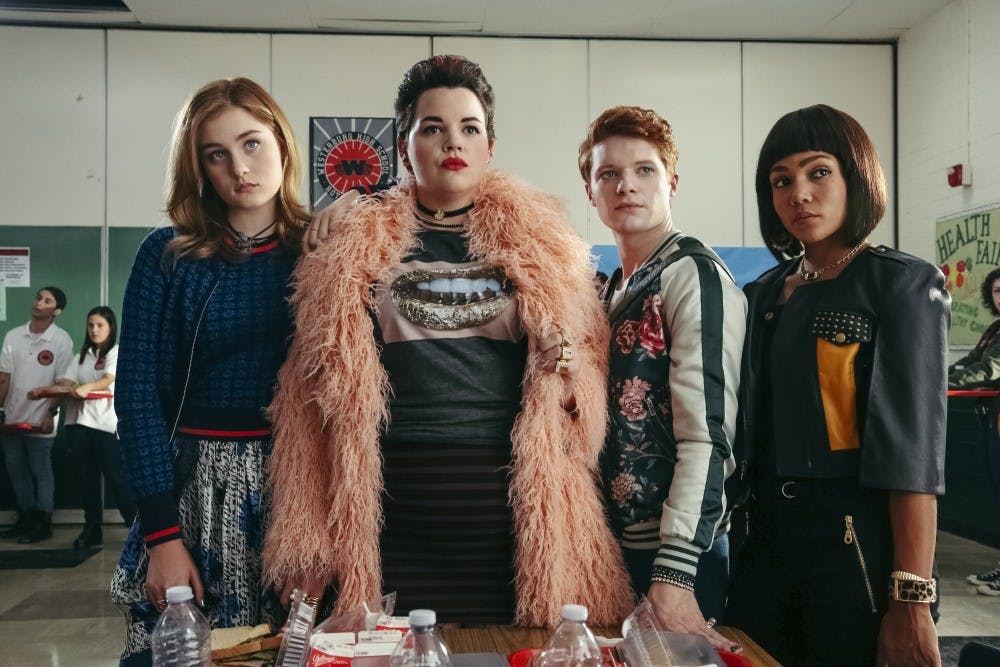Paramount’s Heathers has had a long journey before coming onto the small screen. The project, a modern adaptation of the famous 1989 film starring Winona Ryder and Christian Slater, was slated to go up months ago but was scrapped in June following controversy around its poor handling of school shootings. It is described as a “black comedy” that is a sexier, modern reboot of the original film. Watching Heathers makes it obvious as to why the project was put on the backmost burner.
As for positives, Heathers' best quality is its aesthetics. In fact, it seems that style was the only focus for the majority of the budget rather than, say, good writing or decent casting. The gritty high–school atmosphere which feels blatantly like a ripoff of Riverdale’s revamp of Archie Comics is charming at first but quickly gets heavy–handed. It matches in its heavy–handed, voice–over monologue, the funny gag of a student having sex with a teacher, and the most godawful dialogue I’ve ever heard in my life. Heathers is an amalgamation of the failures of modern high school television. The teachers are flat and rude for seemingly no reason, the characters who we are supposed to like are fundamentally vile, and the picture of high school is so skewed that it feels like we’re in some misshapen collage between the eighties and the modern day.
On that note, a whole issue in itself is the titular Heathers. Chandler (Melanie Field) is a fat woman, McNamara (Jasmine Mathews) is a biracial gay woman, and Duke (Brendan Scannel) is a flamboyant genderqueer person. There is an extended shot of the three of them walking through the halls while people watch like we’re in a John Hughes film. In the iconic high school cafeteria, they call out the jock Ram for wearing a shirt with a racist Native American caricature on it, and this is seen as the first example of their unnecessary cruelty (when actually, they had a point). This is emblematic of the corruption of the high–school comedy–drama: the “groups” are simply stereotypes with people that can be switched out with little care for its implications. What I ask is, in what world are the group of openly queer men and women of color bullying around the attractive jocks?
Even more so, in switching around the all–white female group of Heathers from the 1989 film, the message becomes lost. Veronica is no longer a less social girl who curls into herself yet somehow ends up with the Heathers; instead, she’s a whiny white girl who bemoans the fact that she is basic and a cheerleader and too angelic for everyone around her. Ryder’s Veronica is interesting, flawed, and rebelling; this new version of her is skewed and annoying.
Similarly, JD (James Scully) has none of the charms of Slater. He calls Veronica “my dear” like he is reading lines from a script and acts like the white guy in your philosophy class who smokes weed and only ever talks about vaguely about how his life sucks under “the man.” In the original film, Slater actually has some charisma, but this performance actively knows that he sounds like a raging asshole but believes every word of it.
What is most unfathomable is that the show recognizes that it seems odd in a modern–day world for the fat kids, the trans kids, and the gay kids to be popular, but does not try to clarify why this is happening here. Perhaps one can claim that it isn’t supposed to be realistic and is merely a way to critique PC culture, but frankly, it’s impossible to tell and this world which they have made is entirely nonsensical.
In attempting to modernize a still–relevant classic, Heathers failed to realize any of the messages or critiques in the original film, and instead jumbled up its concepts in trying to make it seem cool, modern, and gritty. It is too caught up in its jokes and clever references to understand the true underpinnings of high school, teenagers, and our culture as a whole. For that, it is a fumble.

